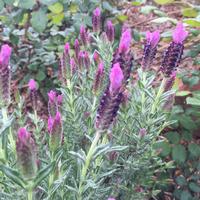Lavender
Lavender has many uses in the home garden. It can be a hedge, border, or part of an herb garden. In culinary use, lavender flowers are used in herbal teas and desserts. There are many more uses for lavender in fragrances, potpourris and sachets, oils, and aromatherapy. The various cultivars of lavender include dwarf forms, pink flowers, blue flowers, and purple flowers. The plants can be grown fairly quickly from seed and will bloom in the first year.
How to grow
- Type: Perennial, semi-evergreen, woody
- Light: Full sun
- Soil: Well drained
- Water: Drought tolerant once established
- Size: 1–3' high, 2–4' wide
When to plant/propagate
- From seed: Sow seeds indoors 8–10 weeks before last frost date. Lavender can also be transplanted successfully in fall.
- Transplants: Transplant in spring after last frost or in fall
- Cuttings: Propagate from cuttings after bloom, or via layering at any time of the year
Harvesting: Harvest the flower heads after bloom
Pruning: Prune after flowering to keep plants from becoming woody
Indoors: Lavender can be grown as an indoor plant with a minimum of 5–6 hours of bright light from a sunny window, or with supplemental light from fluorescent or LED lamps for 14–16 hours a day
Common pests & diseases
More information
- Lavenders for California Gardens, University of California Division of Agriculture and Natural Resources
- Lavender Growing Guide, Cornell University
Recommended Varieties for Santa Clara County
There are no specific recommendations for lavender varieties.







